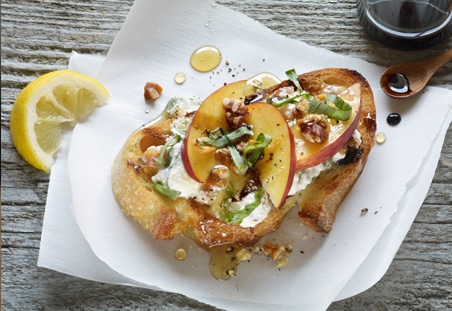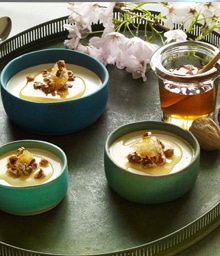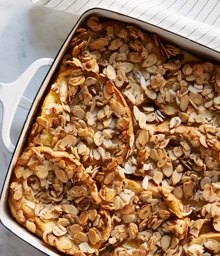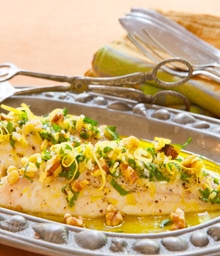 Share on Pinterest
Share on Pinterest
Ricotta-Walnut-Peach Bruschetta
- 30 minutes
- 12 ingredients
- Walnuts
- Moderate
- servings
Ingredients
- 2 cups ricotta cheese
- 2 teaspoons fresh lemon juice
- 1/2 teaspoon salt
- 1 1/2 tablespoons light-colored honey
- 1 cup finely minced Diamond of California® walnuts, lightly toasted
- 2-3 tablespoons fresh basil, cut into thin strips (plus a few leaves for the top)
- 8 thick slices ciabatta, or similar airy artisan brea
- Olive oil
- 2-3 perfectly ripe peaches (could also be nectarines), sliced
- Balsamic reduction
- Freshly ground black pepper
- Lemon wedges for serving
The Steps
- In a medium-sized bowl, mash together the ricotta, lemon juice, salt, honey walnuts and minced basil until combined. Refrigerate until just before serving.
- Shortly before serving, brush the bread slices on both sides with olive oil, and grill in a skillet (a ridged one, if available) over medium heat on both sides until golden.
- Transfer the toasts to a serving plate, and spoon a heap of the ricotta mixture onto each. Arrange a few peach slices on top, drizzle on some Balsamic Reduction, and if you like top each with a few very thin strips of fresh basil. Add a few grinds of black pepper, and serve right away, accompanied by lemon wedges.
Balsamic Reduction:
American versions of balsamic vinegar are fairly sweet, and if you like a touch (just a dot or a stripe) of this effect on savory dishes, you will enjoy the thick result from reducing the vinegar. You can drizzle this syrup over more foods than you might imagine—from roasted vegetables and grain dishes to mashes and grilled tempeh and tofu. It also works on pancakes, fruit, and sorbet. Store Balsamic Syrup in a covered container at room temperature, where it will keep indefinitely. If it solidifies, just zap it in a microwave for a few seconds, or stir in a little boiling water, and it will soften right up again.
1 cup balsamic vinegar
Turn on the stovetop fan and/or open your kitchen windows—the fumes will be intense. Place the vinegar in a small non-aluminum saucepan (a shallow one, if possible) and heat to boiling. Turn the heat down as low as possible, and simmer uncovered for about 20 minutes, or until the vinegar is thick and reduced in volume by about half. (Check it every 5 minutes or so, to be sure it isn’t cooking down too quickly. You don’t want it to go further than slightly more than half its original volume, nor do you want it to burn.)




